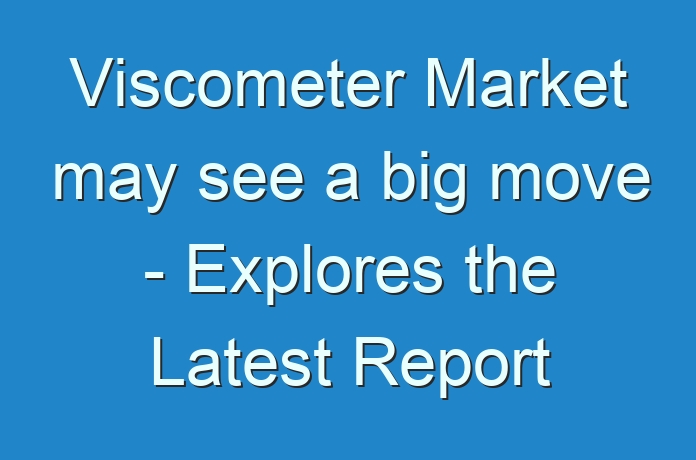
Viscosity is a measure of resistance offered to the flow of fluid due to its internal friction. A viscometer is an instrument which is used to measure the toughness or viscosity of a fluid with one flow condition. Viscometers are used to measure density of liquid, viscosity of zero shear rate, concentration of mixture, relative particle settling rates, intrinsic viscosity of fluid, and viscosity at high pressure and high temperature among others. Viscometer has wide range of applications in material science and chemical industries for materials such as oil, paints, coatings, and adhesives among others. They are also used for personal care products such as cosmetics, shampoo and toothpaste.
Market Dynamics: Global Viscometer Market
The global viscometer market is primarily driven by wide range of applications in various industries such as oil & energy industry, pharmaceutical manufacturing, food and beverage industry, and academics and research laboratories. Incorporation of advanced features in oil & energy industry viscosity measurement plays an important role, such as influencing storage, handling and operational conditions. Moreover, in industrial automation, rotational viscometer is widely used. Rotational viscometer is a type of viscometer which consist of a cylindrical shaped rod which is immersed in the fluid whose viscosity is to be measured. The viscosity is calculated from the measurements of rotational speed of the cylindrical rod and the required torque. Along with this, in food and beverage industry viscosity plays an important role in nearly all production stages. In an industrial food processing, different types of glucose syrup are used to sweeten food and beverages. The syrups are often used as binders in the production of food, as they are sticky. Viscometer is used to measure the viscosity of a syrup. Food containing starch has an adhesive property which highly depend on its viscosity and its flow properties. Viscometers are used to determine the viscosity of starch which has varying characteristics depending on the temperature and the environment. As a result of this, viscometer market is expected to show significant growth in coming years due to its increasing use in food and beverage industry. One of the major restraining factor to the viscometer market is use of rheometer. A rheometer is a device which is more versatile and has a wide range of applications than a viscometer does. However, viscometers used in research laboratory are expected to offer significant growth opportunity to the global viscometer market. As there are various types of viscometers which are used in research laboratories to calculate viscosity of fluid. Among them DVE Viscometer is a device which offers digital display, low cost availability and it is easy to operate.
Planning to lay down future strategy? Perfect your plan with our report sample here https://www.transparencymarketresearch.com/sample/sample.php?flag=S&rep_id=56682
Market Segmentation: Global Viscometer Market
The global viscometer market has been segmented based on type, end-use industry and region. Based on type, the global viscometer market can be classified into standard laboratory viscometer, falling ball viscometer, falling piston viscometer, oscillating piston viscometer, vibrational viscometer, and rotational viscometer. Standard laboratory viscometer is further sub-segmented into U-tube viscometer and falling sphere viscometer. Based on end-use industry, the market can be segmented into oil and gas, chemical, metal and material, food and beverage, academics and research, and others. Also, based on geography the market is further segregated into North America, Europe, Asia Pacific, Middle East & Africa and South America.
Key Players:
Some of the key players operating in the global viscometer market with significant developments include Spectro Scientific, Stony Brook Scientific Ltd., RheoSense Inc., OFI Testing Equipment, Inc., Sofraser, Normalab France SAS, Scientific & Medical Products Ltd., and Process Analysers Systems Ltd. among others. The key players are engaged in customer engagement and retention through development of new and advanced products in the marketplace. For instance, in order to provide the best end-quality for customers, Sofraser manufacturer designed a viscometer which indicate not only viscosity, but also density, temperature and temperature-compensated viscosity. This competitive rivalry is anticipated to fuel the market for viscometer during the forecast period.
The report offers a comprehensive evaluation of the market. It does so via in-depth qualitative insights, historical data, and verifiable projections about market size. The projections featured in the report have been derived using proven research methodologies and assumptions. By doing so, the research report serves as a repository of analysis and information for every facet of the market, including but not limited to: Regional markets, technology, types, and applications.
The study is a source of reliable data on:
- Market segments and sub-segments
- Market trends and dynamics
- Supply and demand
- Market size
- Current trends/opportunities/challenges
- Competitive landscape
- Technological breakthroughs
- Value chain and stakeholder analysis
The regional analysis covers:
- North America (U.S. and Canada)
- Latin America (Mexico, Brazil, Peru, Chile, and others)
- Western Europe (Germany, U.K., France, Spain, Italy, Nordic countries, Belgium, Netherlands, and Luxembourg)
- Eastern Europe (Poland and Russia)
- Asia Pacific (China, India, Japan, ASEAN, Australia, and New Zealand)
- Middle East and Africa (GCC, Southern Africa, and North Africa)
Looking for exclusive market insights from business experts? Buy Now Report here https://www.transparencymarketresearch.com/checkout.php?rep_id=56682<ype=S
The report has been compiled through extensive primary research (through interviews, surveys, and observations of seasoned analysts) and secondary research (which entails reputable paid sources, trade journals, and industry body databases). The report also features a complete qualitative and quantitative assessment by analyzing data gathered from industry analysts and market participants across key points in the industry’s value chain.
A separate analysis of prevailing trends in the parent market, macro- and micro-economic indicators, and regulations and mandates is included under the purview of the study. By doing so, the report projects the attractiveness of each major segment over the forecast period.





